
-
国之瑰宝,艺苑巅峰:大红袍艺术家刘兆光的时代华章
-
执时光之笔 绘华夏神韵——大师风范 冰山
-
国之瑰宝,艺苑巅峰:大红袍艺术家刘慧明的时代华章
-
国之瑰宝,艺苑巅峰:大红袍艺术家陈义水的时代华章
-
国之瑰宝,艺苑巅峰:大红袍艺术家方国营的时代华章
-
国之瑰宝,艺苑巅峰:大红袍艺术家刘慧明的时代华章
-
翰墨颂盛世 丹青庆华诞——全国书画名家·夏训洪 精品巡展
-
笔墨铸丰碑,丹心系寰宇:书法大家王良虎荣膺“欧洲文化艺术终身成就奖”
-
执时光之笔 绘华夏神韵——大师风范 夏训洪
-
砚国春秋·墨韵山河:翰墨名家专题报道:包卫东





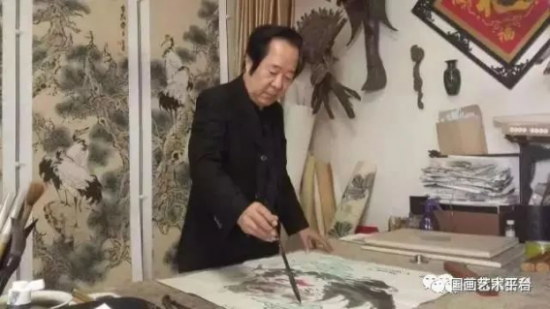
张金荣,天津塘沽人,中国美术家协会会员,一级画师,中央电视台华人频道艺术顾问,原中国美术家协会培训中心常务副主任,中国国际艺术形象大使。现任清华大学美术学院高研班导师。
幼与丹青结缘,喜涂鸦,无方寸,广涉猎,无师承。近年画作以国画写意人物为主,题材多为名人高士,野鹤闲云。花鸟画以鹰、鹤、鸡为多。作品重意境,求神韵,力求雅俗共赏。
1985年加入中国美协,七件美术作品由国家美术馆收藏;
1997年任塘沽政协书画院常务副院长;
2003年调中国美协培训中心;
2006年3月至4月,应法国马赛市政府和亚洲文化节邀请赴法讲学,并成功举办个人画展;当年6月被中国美协任命为培训中心常务副主任,主持工作;
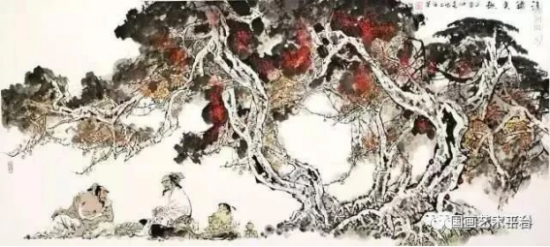
2007年1月至2013年10月,先后六次率中国书画家代表团出访欧亚非澳30个国家和地区进行艺术交流和举办画展。
2010年8月应邀做客中央电视台《华人会客厅》访谈节目,并被聘为艺术顾问;
2012年10月应邀做客北京电视台《艺术人生》访谈节目。
2014年7月,张金荣艺术馆在北戴河海宁路落成开馆。
近年先后获17届国际绘画(dongjing)展金奖,联合国国际文化艺术节联合会国际英伦奖,澳大利亚澳中文化艺术协会授予澳中文化交流贡献奖,台湾中华艺术家联合会授予《终生尊荣》奖,新加坡华人文化艺术中心授予《国际文化艺术爱心大使》称号,中国书画世界行联合会授予国际传播金奖,第17届CCTV中华世纪英才称号等。
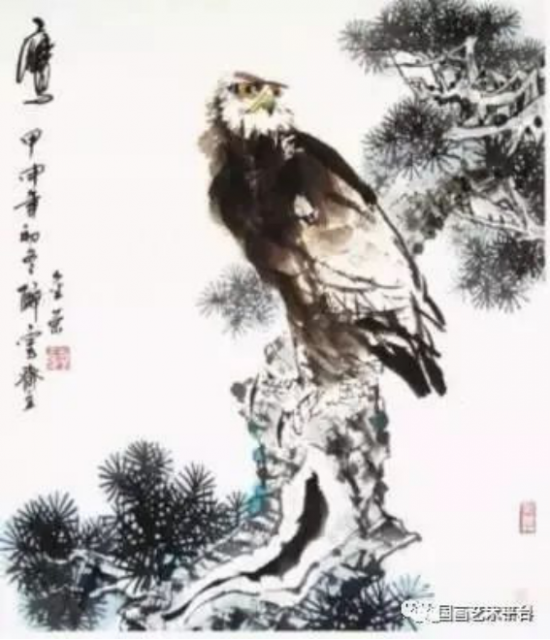
品读张金荣国画新作
——感受艺术纯意境之美
中国画作为我国传统的绘画艺术,继承了我国文化的主要内涵,是对我国文化的一种形象化的表达。在中国画中我们能够感受到华夏文化的博大精深和对于文化的更加深层次的理解方式。中国画在绘画中讲究的是对于意境的一种表达,往往画中包含着丰富的艺术内涵,从中国画中体现得最多的还是一种意境的精神,随着中国画在当代绘画艺术中的不断发展,从而有了更加广阔的发展空间。

张金荣是一位对于中国画(下称国画)有着执着追求的画家,他对于国画有着很深厚理论修养和扎实的绘画功底,是当代难得的一位实力派画家。从他的绘画作品中感受到了国画最为真切的艺术魅力,保留着国画传统的绘画意境,结合当代艺术发展的特点,从中不断的积累融合,最后形成了他自己独有的国画绘画风格,对于人物和花鸟绘画亦有着自己独特的理解。看到他近年的部分作品,发现他的画作不拘一格,形式多变,对于不同的绘画对象运用不同的绘画技巧,从而形成了更加迥异的画面特点。雄鹰是他喜欢的绘画题材之一,或雄踞松石,或翱翔长空。对于鹰这种动物的描绘,他笔锋犀利,纵情挥洒,整幅作品充满了刚劲的气势,在画面中用更加刚毅的线条来突出鹰的雄姿和霸气,让我们能够直观的感受雄鹰的凌烈姿态,在他的笔下,以公鸡作为主角的作品则显得充满了生活的情趣,画面柔和了许多,也更加丰富,将国画中色墨相融的技巧发挥到淋漓尽致。欣赏张金荣的国画作品,完全就是一种美的享受,是对于国画艺术的又一次膜拜。他用自己的笔墨开创了一个更加富有现代感的国画天地,从中仍然能够感受到国画那磅礴大气的意境之美,从中欣赏到的不仅仅是国画对于我们现实的一种艺术上的升华,更加能够感觉到画家自身的人格魅力,这些融入画中,让绘画作品更加显现出十足的艺术价值。张金荣的国画花鸟,用笔灵动,线条飘逸俊朗,形象生动洒脱,有着名家的气质和风范。画面松树老干苍劲有力,老辣润泽,用极简练的笔触,构成了疏朗的空间,与缜密的松针形成鲜明的对比,疏能走马,密不透风。两只仙鹤栖息在松树的主干上,勾画出了人们喜闻乐见的通俗题材-健康长寿,松鹤延年。在造型刻画上,仙鹤神情安定,胜似闲庭信步,给人一种与世无争,泰然处之,安居乐业,幸福美满的感觉。最值得一提的是整个画面线条老辣而又苍润,不出干笔,多以湿笔运行,所以感觉流畅、滋润,有韵律在舞动,你的心情也会随之荡漾。 张金荣的国画,可以说是纯文人画。有着丰富的文化内涵,古朴、典雅、厚重、沧桑,饱含丰富的中国古典哲学。他的绘画不追求形似,而刻意追求神似,所以他的画,无论是人物,还是动物,甚至是一草一木,都能达到传神的效果。这应该得力于他的工作,身为培训中心副主任,自然要研究画理,研究中国文化,研究中国历史,理所当然应该深明中国古典哲学的深奥,对中国画的诗、书、画、印,都应该有着深入的理解和掌握,不然他怎么会有如此高的艺术境界呢?张金荣国画,花鸟也好,人物也好,根植于中国画的传统。他功力深厚,挥洒自如,继承和发扬了中国画。特别是在用线方面,有着独到之处。他的线条是跳跃的,是舞动的,不说别的,单几根线条就能打动人,可见其功力非一般人所能为。
具有创作难度的人物画在艺术品投资市场上一直是收藏的热门,其中以写意的笔墨来描绘造型各异人物形象的画作更是成为热点。在博宝网合作艺术家张金荣的画笔下就将独特的造型和笔墨分配合理的人物形象传神地展现出来,受到众多的国画收藏爱好者交口称赞。出生于天津塘沽的画家张金荣是一位自己学习美术创作并擅长中国画创作的艺术家。在学习绘画创作艺术途中,先生曾经在中国书画函大、天津工艺美院大专系等地进修,让其在理论学习和实践创作中提升了艺术功底和素养。张金荣的水墨人物画大多取法后者,多年来他潜心研究人物画的衣纹样式,一点一画、一拖一摆均在力求凸显线条的美感,为充分发挥书写用笔的特性铺出水墨平台。他塑造人物的线条感强烈,即体现了准确的人体结构和夸张有度的动态,又具备书法艺术的一张一弛节律,合乎章法和浪漫气韵。赏读其画便有轻松自如、清丽俊逸之感。金荣水墨人物画线条呈现出的艺术魅力,主要得益于他早年创作连环画用笔勾线的造型基础和疏密有致的巧思。张金荣水墨人物画用墨用色也很到位。墨色浓淡相宜,既有淡淡的阴柔墨韵,又有浓重的阳刚墨块。
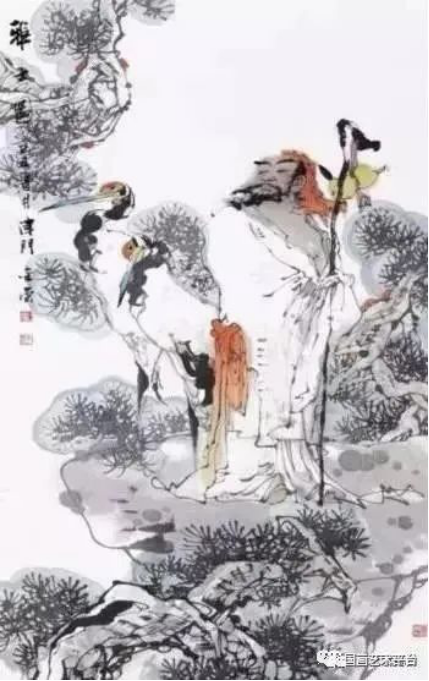
用色则是以少少许剩许许多,只在局部小面积使用浓艳的朱砂、石青、石绿、石黄……与大面积的浓淡墨形成对比呼应,呈现出水温不火、艳而不俗的美感。总之,张金荣的水墨人物画已经形成个人的面貌和风格并在不断走向成熟精致,至于他的牡丹、雄鹰等题材的佳作,本文文字数所限,不再赘述。 书画这碗饭好吃。古往今来,书画家的名字单列出来就可以编撰多部大辞典。吸收这个门派,参照那个大家,洋洋洒洒,弄出来总是七七八八,有点模样。书画这碗饭难端。你不经意的画一笔,人家说你有王羲之的笔意,你顺便抹上几笔,人家说有点石涛或八大家的感觉,不细品还以为是在捧你呢。看似左右逢源,实在是左右为难。关键是寻找自己,认识自己,发掘自己,完善自己。人生苦短,而艺海无涯。浅涉水者见虾,其颇深者察鱼鳖,其尤甚者观蛟龙。本文结尾时发些感慨,意在与书画共勉。功夫在画外,比到最后比的是修养。张金荣应邀赴法讲学办展中国美术家协会会员、中国美协培训中心教授、国画家张金荣应法国马塞文化艺术中心和布朗奎克市长的邀请,于今年3月7日至4月7日赴法国进行了为期一个月的讲学和艺术交流活动、并在马塞等地举办了个人画展,受到当地政府和各界人士的热情接待和欢迎。 3月10日,《中国画家张金荣国画展》在马塞文化艺术中心开幕。布朗奎克市长、马塞文化艺术中心主席黛贺兹让、马塞职业艺术家协会负责人及各界人士百余人出席了画展开幕式。张金荣是中国第一位在马塞市举办中国画展的画家。他笔下的古典人物清俊飘逸,牡丹艳彩纷呈,雄鹰和公鸡也各具特色,深受法国观众喜爱。展出的40件作品除用于礼品馈赠外,其余均由当地政府、文化艺术中心和职业艺术家协会及各界人士收藏。 张金荣还应邀在马塞等地举办了16场中国画艺术讲座,场场座无虚席。近200位法国的职业画家、教师和中国画艺术爱好者听取了讲座、并给予了很高的评价。
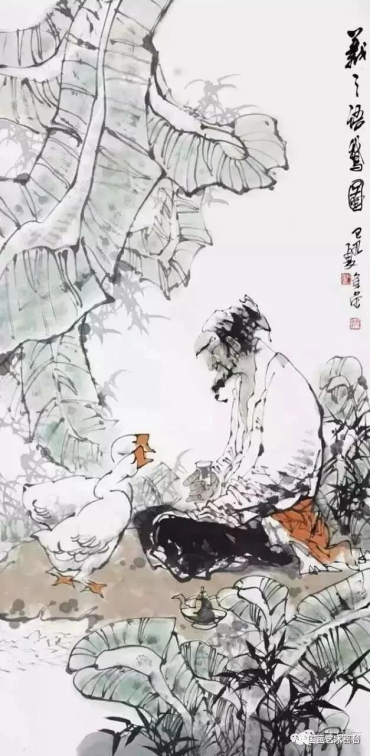
马塞省级大报和市长通讯均专题报道了张金荣的画展和讲学活动。在主办方的安排下,张金荣还赴西班牙、摩纳哥进行了艺术交流,到尼斯、嘎纳及凡高的故居观光采风,并出席了在尼斯图思举办的亚洲文化艺术节。张金荣近年来在中国美协培训中心工作之余,在写意中国画的沃土上辛勤耕耘,大胆探索、反复实践,终使自己的作品初具风格,并走出国门,为向西方世界推介中国画传统艺术,为中法两国人民的文化交流作出了贡献。
Zhang Jinrong, born in Tanggu, Tianjin, is a member of the China Artists Association, a first-class painter, an art consultant for the CCTV Chinese Channel, former Executive Deputy Director of the China Artists Association Training Center, and China International Art Image Ambassador. Current supervisor of the advanced research class at the School of Fine Arts, Tsinghua University.
Childhood and painting are intertwined, fond of graffiti, lack of space, extensive knowledge, and lack of mentorship. In recent years, his paintings have mainly focused on freehand characters in traditional Chinese painting, with themes mainly featuring celebrities, scholars, and wild cranes and leisurely clouds. Flower and bird paintings are mainly composed of eagles, cranes, and chickens. The work emphasizes artistic conception, seeks spiritual charm, and strives for both refined and popular appreciation.
Joined the China Artists Association in 1985, and seven artworks were collected by the National Art Museum;
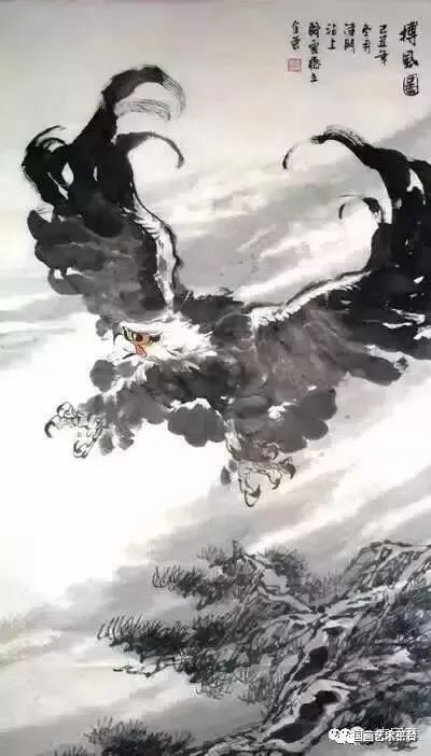
In 1997, he was appointed as the Executive Vice President of the Tanggu Political Consultative Conference Painting and Calligraphy Institute;

In 2003, transferred to the China Artists Association Training Center;
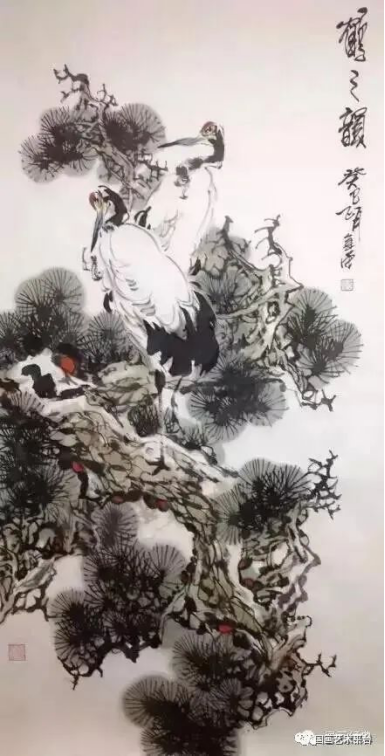
From March to April 2006, I was invited by the Marseille City Government and the Asian Cultural Festival in France to give lectures and successfully held a personal art exhibition; In June of that year, he was appointed as the Executive Deputy Director of the Training Center by the China Artists Association, responsible for his work;
From January 2007 to October 2013, he led a delegation of Chinese calligraphers and painters to visit 30 countries and regions in Europe, Asia, Africa, and Australia six times for artistic exchanges and exhibitions.
In August 2010, I was invited to participate in the interview program "Chinese Reception Hall" on CCTV and was hired as an art consultant;
In October 2012, I was invited to participate in the interview program "Art Life" on Beijing Television.
In July 2014, the Zhang Jinrong Art Museum was completed and opened on Haining Road in Beidaihe.
In recent years, he has won the Gold Award at the 17th International Painting Exhibition, the International British Award from the United Nations International Cultural and Art Festival Federation, the Contribution Award for Cultural Exchange between Australia and China from the Australia China Cultural and Art Association, the Lifetime Honor Award from the Taiwan Chinese Artists Federation, the title of "Ambassador of International Cultural and Art Love" from the Singapore Chinese Cultural and Art Center, the International Communication Gold Award from the China Calligraphy and Painting World Federation, and the 17th CCTV Chinese Century Talent Award.
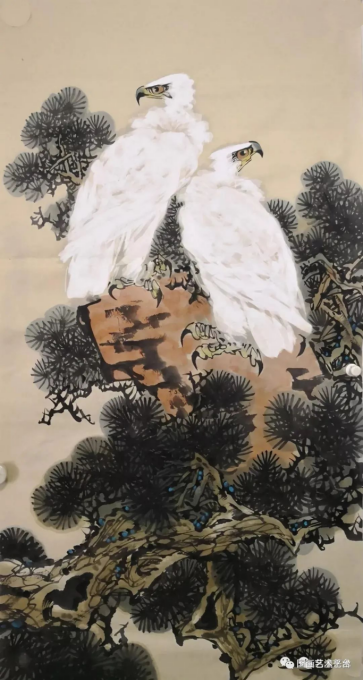
Appreciating Zhang Jinrong's New Chinese Painting Works
——Experience the beauty of pure artistic conception
Chinese painting, as a traditional art form in China, inherits the main connotations of Chinese culture and is a visual expression of Chinese culture. In Chinese painting, we can feel the vastness and profoundness of Chinese culture, as well as a deeper understanding of culture. Chinese painting emphasizes the expression of artistic conception in painting, often containing rich artistic connotations. The spirit of artistic conception is most reflected in Chinese painting. With the continuous development of Chinese painting in contemporary painting art, there is a broader space for development.
Zhang Jinrong is a painter who has a persistent pursuit of Chinese painting (hereinafter referred to as traditional Chinese painting). He has a deep theoretical cultivation and solid painting skills in traditional Chinese painting, making him a rare and powerful contemporary painter. I feel the most authentic artistic charm of Chinese painting from his paintings, preserving the traditional artistic conception of Chinese painting. Combining with the characteristics of contemporary art development, I continuously accumulate and integrate them, and finally form my own unique style of Chinese painting. I also have my own unique understanding of character and flower and bird painting. Seeing some of his recent works, I found that his paintings are not confined to a particular style and have diverse forms. Different painting techniques are applied to different objects, resulting in more distinct visual characteristics. Eagle is one of his favorite painting themes, either perching on turquoise or soaring in the sky. For the depiction of eagles as animals, his pen is sharp and unrestrained, and the entire work is full of vigorous momentum. In the picture, more resolute lines are used to highlight the majestic and domineering posture of eagles, allowing us to intuitively feel the fierce posture of eagles. In his writing, works with roosters as the protagonist appear full of life's charm, the picture is much softer and richer, and the technique of blending color and ink in traditional Chinese painting is fully utilized. Appreciating Zhang Jinrong's traditional Chinese paintings is a complete enjoyment of beauty, and it is another worship of traditional Chinese painting art. He created a more modern world of traditional Chinese painting with his own pen and ink, from which he can still feel the majestic and atmospheric beauty of traditional Chinese painting. From it, he not only appreciates the artistic sublimation of traditional Chinese painting to our reality, but also feels the personal charm of the painter. These elements are integrated into the painting, making the artwork more prominent in terms of artistic value. Zhang Jinrong's traditional Chinese painting of flowers and birds is characterized by agile brushstrokes, graceful and handsome lines, vivid and free spirited images, and exudes the temperament and style of a famous artist. The picture depicts the vigorous and powerful old trunk of the pine tree, which is spicy and moist. With extremely concise brushstrokes, it creates a sparse and clear space, forming a sharp contrast with the meticulous pine needles. Sparse trees can move freely, but dense ones are not breathable. Two cranes perch on the main trunk of a pine tree, depicting popular themes that people enjoy - health and longevity, pine and crane longevity. In terms of styling, the crane has a calm expression, more like strolling leisurely in the courtyard, giving people a feeling of being independent, calm, peaceful, and happy. The most noteworthy thing is that the entire picture has spicy and lush lines, with no dry strokes and mostly wet strokes, so it feels smooth and moist, with rhythm dancing, and your mood will also fluctuate accordingly. Zhang Jinrong's traditional Chinese painting can be said to be pure literati painting. It has rich cultural connotations, ancient simplicity, elegance, weightiness, and vicissitudes, full of rich Chinese classical philosophy. His paintings do not pursue resemblance in form, but deliberately pursue resemblance in spirit, so his paintings, whether they are characters, animals, or even plants and trees, can achieve a vivid effect. This should be thanks to his work. As the deputy director of the training center, he naturally needs to study painting theory, Chinese culture, and Chinese history. Of course, he should have a deep understanding of the profoundness of Chinese classical philosophy, and have a deep understanding and mastery of the poetry, calligraphy, painting, and printing of Chinese painting. Otherwise, how could he have such a high artistic level? Zhang Jinrong's traditional Chinese painting, whether it's flowers and birds or characters, is rooted in the tradition of Chinese painting. He has profound skills and is able to wield freely, inheriting and promoting Chinese painting. Especially in terms of using wires, it has unique features. His lines are jumping and dancing. Not to mention anything else, just a few lines can move people, indicating that his skills are beyond the reach of ordinary people.
Character paintings with creative difficulty have always been a hot topic in the art investment market, and using freehand brushstrokes to depict various character images has become a hot topic. Under the brush of Zhang Jinrong, a collaborative artist on Bobao, unique shapes and well-designed character images are vividly displayed, receiving praise from numerous Chinese painting collectors. Zhang Jinrong, a painter born in Tanggu, Tianjin, is an artist who has studied art creation and is skilled in Chinese painting. On the way to learning painting and creative art, the teacher has studied at various universities such as China Correspondence University of Calligraphy and Painting and Tianjin Institute of Arts and Crafts, which has enhanced his artistic skills and literacy through theoretical learning and practical creation. Most of Zhang Jinrong's ink figure paintings are based on the latter. For many years, he has devoted himself to studying the patterns and styles of character paintings. He has been striving to highlight the beauty of lines by drawing and dragging, laying a platform for ink painting to fully utilize the characteristics of writing. He has a strong sense of lines in shaping characters, which not only reflect accurate human body structure and exaggerated dynamics, but also possess the rhythmic rhythm of calligraphy, in line with the rules and romantic charm. Appreciating his paintings gives a relaxed and graceful feeling. The artistic charm presented by the lines in Jin Rong's ink figure paintings is mainly due to his early creation of comic strips with a solid foundation of brushstrokes and clever thinking in density. Zhang Jinrong's ink figure painting also uses ink and color very well. The ink color is appropriate in intensity, with a light and gentle ink charm as well as a strong and masculine ink block.
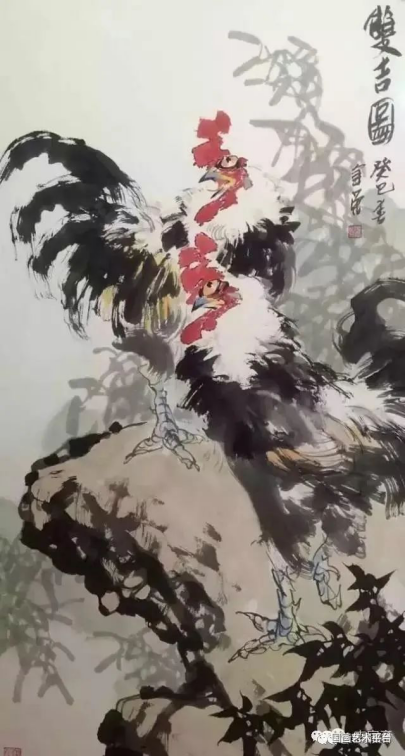
The use of colors is to use a small amount of leftover, only in small areas, using strong and vibrant cinnabar, stone blue, stone green, stone yellow... in contrast to the large area of thick and light ink, presenting a beautiful feeling of not being too hot, bright, and vulgar. In short, Zhang Jinrong's ink figure paintings have formed his personal appearance and style, and are constantly moving towards maturity and refinement. As for his masterpieces on themes such as peonies and eagles, the number of words in this article is limited and will not be repeated. Calligraphy and painting make this bowl of rice delicious. Throughout history, the names of calligraphers and painters can be listed separately to compile multiple dictionaries. Absorbing this sect, following the example of those who excel in it, they always come out in various ways, with a certain appearance. Calligraphy and painting make this bowl of rice difficult to serve. You casually draw a stroke, and they say you have Wang Xizhi's brushwork. You also add a few strokes, and they say it feels a bit like Shi Tao or the Eight Great Masters. If you don't take a closer look, you might think it's just praising you. It seems to be a win-win situation, but it's really a dilemma. The key is to find oneself, get to know oneself, discover oneself, and improve oneself. Life is short, but the sea of art is boundless. Shallow waders see shrimp, those who are quite deep observe fish and turtles, and those who are particularly severe observe dragons. At the end of this article, I would like to express some emotions, with the intention of sharing inspiration with calligraphy and painting. Kung Fu is beyond the painting, and in the end, it is about cultivation. Zhang Jinrong was invited to France to give lectures and exhibitions. He is a member of the China Artists Association, a professor at the China Artists Association Training Center, and a Chinese painter. At the invitation of the Marseille Cultural and Art Center and the Mayor of Bronqueque, Zhang Jinrong went to France from March 7th to April 7th this year for a one month lecture and art exchange activity. He also held a personal art exhibition in Marseille and other places, and was warmly received and welcomed by the local government and people from all walks of life. On March 10th, the "Chinese Painter Zhang Jinrong National Painting Exhibition" opened at the Massey Cultural and Art Center. More than a hundred people attended the opening ceremony of the art exhibition, including Mayor Brunqueque, Chairman of the Massey Cultural and Art Center, Dahezjan, Head of the Massey Professional Artists Association, and people from all walks of life. Zhang Jinrong is the first Chinese painter to hold a Chinese art exhibition in Massey City. His classical characters are handsome and elegant, with colorful peonies and distinctive eagles and roosters, which are deeply loved by French audiences. The 40 exhibited works, apart from being used for gift giving, are all collected by local governments, cultural and art centers, professional artist associations, and individuals from all walks of life. Zhang Jinrong was also invited to hold 16 lectures on Chinese painting art in places such as Massey, with no empty seats. Nearly 200 French professional painters, teachers, and Chinese painting enthusiasts attended the lecture and gave high praise.
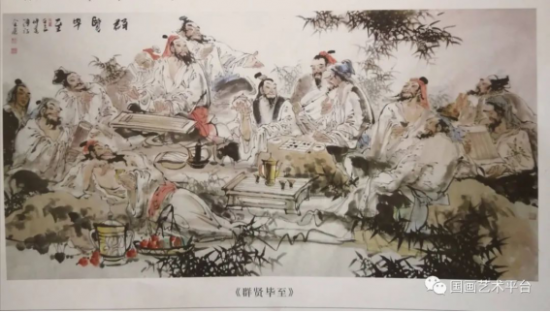
Both the Masai Provincial Newspaper and the Mayor's Newsletter featured special reports on Zhang Jinrong's art exhibition and lecture activities. Under the arrangement of the organizer, Zhang Jinrong also went to Spain and Monaco for artistic exchanges, visited the former residences of Nice, Cannes, and Van Gogh for sightseeing and art, and attended the Asian Cultural and Art Festival held in Nice. In recent years, in addition to working at the China Artists Association Training Center, Zhang Jinrong has worked hard on the fertile soil of freehand Chinese painting, boldly exploring and repeatedly practicing, ultimately giving his works a new style and going abroad. He has made contributions to promoting traditional Chinese painting art to the Western world and cultural exchanges between the people of China and France.
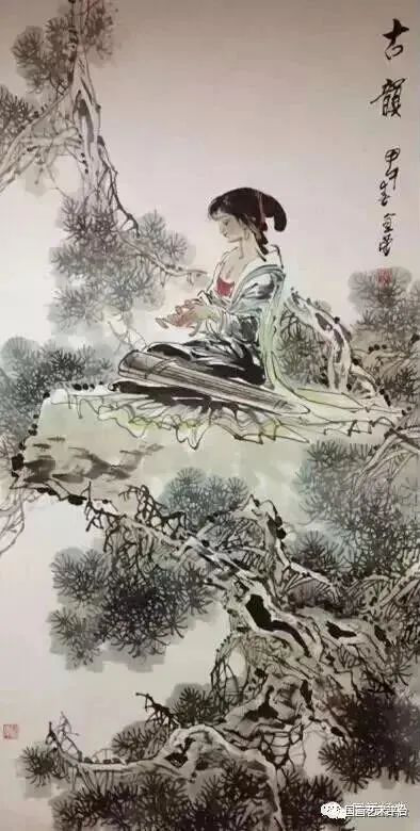
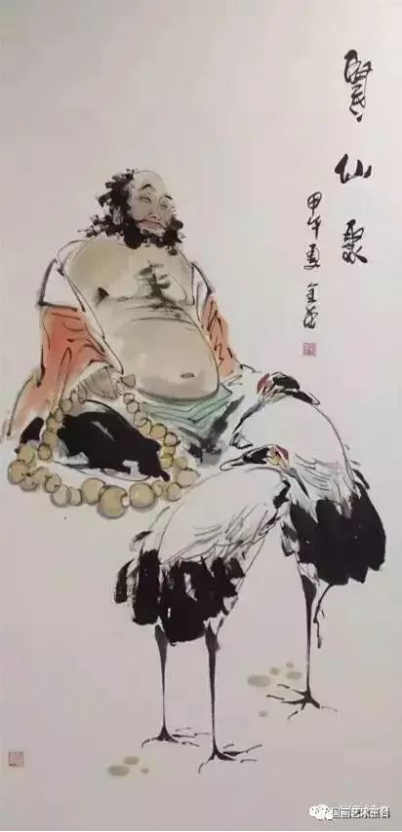



主办:国宾礼书画网
中华人民共和国信息产业部备案号:鲁ICP备19024041号-1